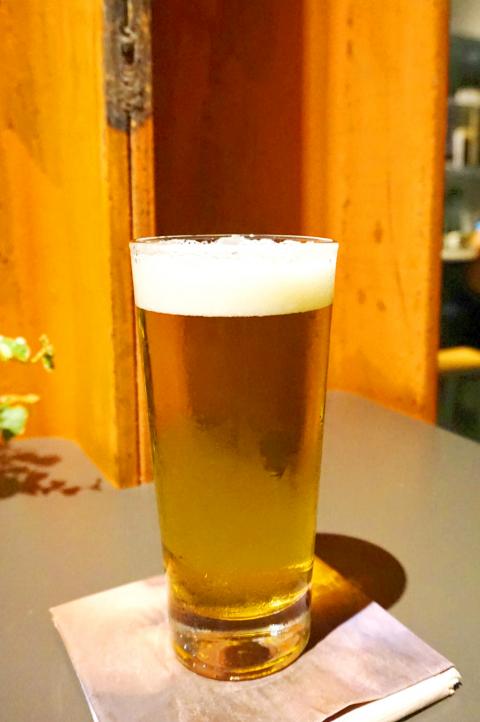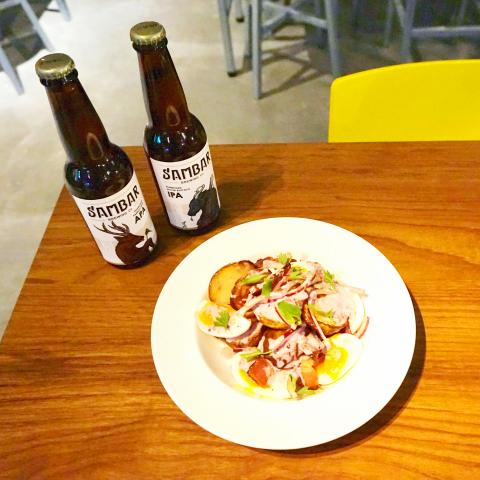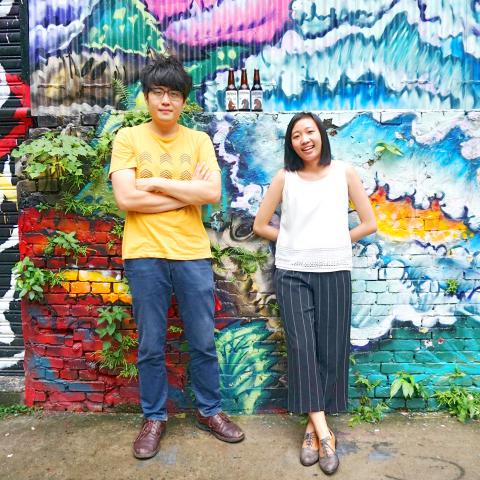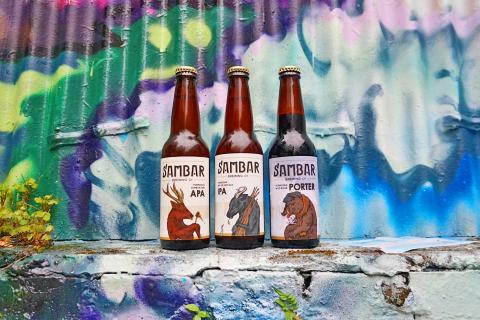When Ting Ting (丁鼎) returned to Taiwan in 2014 after studying abroad in London and Prague, the thing he missed most was craft beer. The ales and pilsners therewere good and cheap, even cheaper than water.
“I drank beer almost every day,” the 28-year-old tells me. “Every meal I had in a Chinese restaurant in the Czech Republic was accompanied by a pilsner.”
I meet with him and his business partner, Astrid Huang (黃婉綺), 26, at Woolloomooloo Out West in Taipei’s Ximending (西門町) area a few days ago. Earlier that day, the duo was overseeing operations at their contract brewery in Hsinchu.

Photo: Dana Ter, Taipei Times
Ting says one of the first things he did upon returning to Taiwan was purchase his own homebrewing equipment online and having it shipped from the US. He ordered his hops and malts from Pacific Brew Craft (金鼎豐), a Taichung-based home brew supplier.
“There were a lot of disasters in the beginning,” Ting says of his initial attempts to brew pale ales.
After months of trial and error, he released his first beer, the Sambar Deer APA (American pale ale) last year, and Sambar Brewing (水鹿精釀) was born.

Photo: Dana Ter, Taipei Times
The Formosan sambar deer was chosen as the brewery’s mascot because Taiwan is mountainous but surrounded by water, and the sambar deer lives in the mountains while its Chinese name bears the character shui (水), or water. Despite its size — it’s almost like a “little cow” according to Huang — the animal is gentle and friendly. So it makes sense that the APA, which is made with wheat from Changhua (彰化) and honey from Miaoli (苗栗), is a light brew with a balanced hop bitterness and slight honey taste.
Sambar Brewing’s two other beers, the Water Buffalo IPA (India pale ale) and Wild Boar Porter, are also named after animals native to Taiwan. The IPA is a much stronger concoction, boasting a tangy bitterness characteristic of the quintessential American-style variety. The porter, which will officially be released at the end of the month, is a more complex creation with hints of dark coffee. Like the APA, the ingredients used to make the porter, including buckwheat and coffee beans, are sourced locally.
PERSONAL TOUCH

Photo: Dana Ter, Taipei Times
Ting says taking the leap from homebrewing to commercial brewing came with a steep learning curve.
“As a homebrewer, your main concern is making beer,” says Ting. “Running a brewery, on the other hand, is essentially like running a business, one where you need to worry about cash flow, quality control, customer satisfaction and other factors.”
He says that he survives because he “loves beer” — but of course, there’s more to it than that. Sambar Brewing entered the market at the right time, when craft beer had already become sort of a fad. Other microbreweries such as Redpoint, 23 Brewing and 55th Street had released beers just before Sambar.

Photo: Dana Ter, Taipei Times
Like the aforementioned breweries, Sambar Brewing’s Facebook page is updated constantly, with daily posts — normally pictures of Ting, Huang and their customers drinking beer at restaurants, festivals and what not. In fact, the brewery has gained much visibility from participating in a number of beer festivals, including BeerFes, held at Huashan 1914 Creative Park (華山1914) in Taipei, and the Wow Hsinchu Craft Beer Festival (精釀啤酒節窩新竹).
They’ve also set up booths at a couple of music festivals, and last week, Ting and Huang were in Tainan giving a talk about craft beer at Realguts Cafe (特有種商行). It was one of the many seminars hosted by cafes around Taiwan that they’ve been invited to speak at. Huang says these seminars are not just good opportunities for them to meet and network with restaurant and bar owners, but also provide a chance to talk to customers and share with them what craft beer is all about.
“People want to know more about craft brewing — the process, the ingredients, the difference between an APA and IPA,” she says.
Huang finds that the tastes of Taiwanese consumers are changing. Whereas the majority once stuck to pilsners, lagers and other light beers, she’s seen more customers try stouts and porters — which have a much higher alcohol by volume — at beer festivals and other tasting events.
Ting says it’s about the personal touch: “It’s not just about drinking beer, but it helps to know the story behind the beverage and the personalities who brewed it.”
YOUNG AND BRAVE
When I ask the duo why they think so many young entrepreneurs like themselves are entering the craft brewing industry, Huang chuckles.
“Because we’re brave, we don’t understand the risks,” she quips.
Ting prefers to think of it as a lifestyle choice. Since starting Sambar Brewing, he’s traveled all over Taiwan not just to take part in music and beer events, but also to source ingredients. He recently traveled to China, where he visited Great Leap Brewery in Beijing, and was impressed by how they utilize local Chinese ingredients such as Sichuan pepper and Oolong tea.
The sense of freedom is definitely one of the perks of the jobs, along with the thrill of being a part of the most recent craft beer wave sweeping not just Taiwan, but the rest of Asia. Ting says that the first wave, which took place in 2002 when Taiwan joined the World Trade Organization and legalized private breweries, failed primarily because breweries were investing too much money into a market that was too small at the time.
“I think young people are more sensitive to trends,” Ting says.
Ting and Huang both say that this time around, education is key. Hence the seminars, festivals and copious use of social media.
But much of this education also comes from sharing a pint with friends. Ting mentions that a number of his friends have come to appreciate craft beer because of him, and for friends who have also studied abroad, enjoying a tipple together brings back fond memories.
“It reminds us of the good old days,” he adds.
Warning: Excessive consumption of alcohol can damage your health.
Taipei is a city that has positioned itself as being cheap and fast, but the revolution for craft drinks is taking wind and alcohol aficionados are thirsty for more. Drinking Taipei is a monthly column devoted to spotlighting chic, conceptual bars that aren’t your typical watering hole.

May 11 to May 18 The original Taichung Railway Station was long thought to have been completely razed. Opening on May 15, 1905, the one-story wooden structure soon outgrew its purpose and was replaced in 1917 by a grandiose, Western-style station. During construction on the third-generation station in 2017, workers discovered the service pit for the original station’s locomotive depot. A year later, a small wooden building on site was determined by historians to be the first stationmaster’s office, built around 1908. With these findings, the Taichung Railway Station Cultural Park now boasts that it has

Wooden houses wedged between concrete, crumbling brick facades with roofs gaping to the sky, and tiled art deco buildings down narrow alleyways: Taichung Central District’s (中區) aging architecture reveals both the allure and reality of the old downtown. From Indigenous settlement to capital under Qing Dynasty rule through to Japanese colonization, Taichung’s Central District holds a long and layered history. The bygone beauty of its streets once earned it the nickname “Little Kyoto.” Since the late eighties, however, the shifting of economic and government centers westward signaled a gradual decline in the area’s evolving fortunes. With the regeneration of the once

The latest Formosa poll released at the end of last month shows confidence in President William Lai (賴清德) plunged 8.1 percent, while satisfaction with the Lai administration fared worse with a drop of 8.5 percent. Those lacking confidence in Lai jumped by 6 percent and dissatisfaction in his administration spiked up 6.7 percent. Confidence in Lai is still strong at 48.6 percent, compared to 43 percent lacking confidence — but this is his worst result overall since he took office. For the first time, dissatisfaction with his administration surpassed satisfaction, 47.3 to 47.1 percent. Though statistically a tie, for most

In February of this year the Taipei Times reported on the visit of Lienchiang County Commissioner Wang Chung-ming (王忠銘) of the Chinese Nationalist Party (KMT) and a delegation to a lantern festival in Fuzhou’s Mawei District in Fujian Province. “Today, Mawei and Matsu jointly marked the lantern festival,” Wang was quoted as saying, adding that both sides “being of one people,” is a cause for joy. Wang was passing around a common claim of officials of the People’s Republic of China (PRC) and the PRC’s allies and supporters in Taiwan — KMT and the Taiwan People’s Party — and elsewhere: Taiwan and